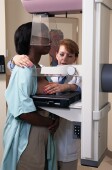
FRIDAY, Nov. 20 (HealthDay News) — Women can rest assured, at least for now, that their health plan will continue to pay for an annual mammogram beginning at age 40.
A firestorm set off this week by a federal task force recommendation against “routine screening” of women under 50 is not likely to spur hasty changes in coverage policies, experts say.
“We’re not hearing that coverage is going to change. We’re hearing that coverage will continue pretty much as it has been,” said Susan Pisano, vice president of communications for America’s Health Insurance Plans in Washington, D.C.
Randall Abbott, a senior health care consultant in the Boston office of Watson Wyatt Worldwide, has talked to most major health plans and numerous “self-funded” employers — companies that bear the cost of employee medical claims and administer their own insurance plans — and all are taking the recommendations “under advisement,” he said.
Insurers and employers will likely “delay taking any action until more of a consensus has been reached among the warring parties,” he said.
The new U.S. Preventive Services Task Force guidelines, published in the current issue of the Annals of Internal Medicine, suggest that women can postpone having a routine mammogram until age 50. It used to recommend those screenings for women in their 40s. And instead of screening every year, it now says screening can take place every two years.
A woman’s decision to start earlier, the task force added, “should be an individual one,” weighing the benefits and harms, such as false-positive results and unnecessary biopsies.
The new advice prompted an outcry from patient advocacy groups and professional societies that urge women to continue getting annual mammograms beginning at age 40.
Most health plans craft their own coverage policies using guidance from professional medical societies, such as the American Cancer Society and American College of Obstetricians and Gynecologists, as well as the government panel that issued the controversial recommendations, Abbott said.
In addition, most states have laws on the books requiring health insurers to pay all or part of the cost of screening mammograms, according to the National Cancer Institute. Insurers that do business in a state must abide by the law.
However, according to an annual survey by the Henry J. Kaiser Family Foundation and Health Research & Educational Trust, more than half (57 percent) of all employees receiving health-care coverage from an employer are in “self-funded” plans, and these plans are exempt from state laws.
Medicare, the federal health program for older and disabled Americans, covers annual mammograms starting at age 40, and, according to a statement from Health and Human Services Secretary Kathleen Sebelius, that won’t change. On Thursday, she urged women to “keep doing what you have been doing for years.”
“That’s reassuring,” acknowledged Joanna Morales, director of the Los Angeles-based Cancer Legal Resource Center, “but we definitely don’t want to see a movement by private insurance companies to try to use these guidelines as an excuse to continue to reduce access to care for women.”
The national average price for a mammogram is $105, including the cost of the X-ray and the physician’s fee for interpreting the results, according to Healthcarebluebook.com.
“That would represent what most providers accept from insurance companies as payment in full,” explained Dr. Jeffrey J. Rice, chief executive officer of the online pricing guide. However, providers may not honor that rate if insurers decide not to cover mammograms before age 50, and in that case, women could be billed upwards of $400, he said.
Minneapolis-based UnitedHealthcare said in a statement that the ongoing study of mammography testing provides “additional perspectives that can lead to new recommendations from the medical community.”
It added that the screening decision “requires a detailed discussion between the patient and her physician, and it should consider the medical evidence, patient preferences and unique clinical issues for each patient.”
Chris Curran, director of corporate communications for Cigna Corp. in Philadelphia, also characterized mammography screening as an “individual decision” based on a woman’s specific circumstances and medical history.
“Our current coverage policy provides for coverage of screening mammography beginning at age 40, or as young as 25 if a woman is in a high-risk category, and continues to remain in effect,” he said.
More information
For more on breast cancer, see the U.S. National Cancer Institute.

